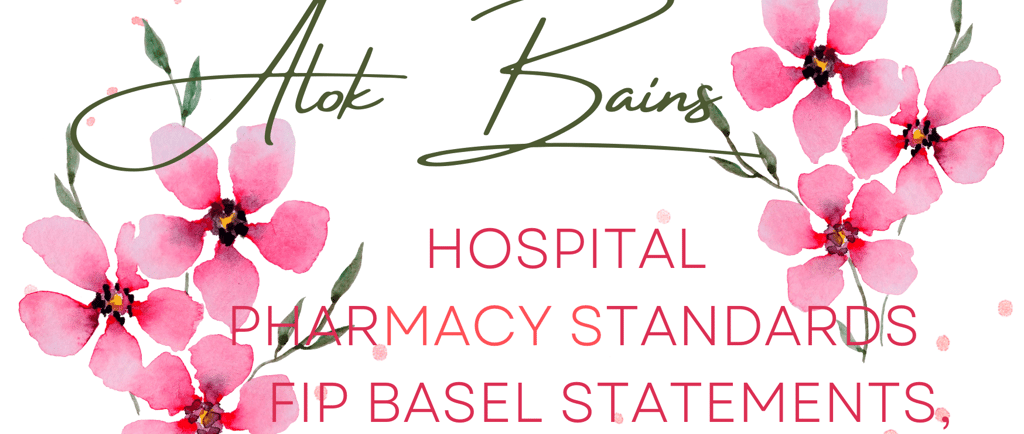Hospital Pharmacy Standard FIP Basel Statement
Hospital Pharmacy Standard (FIP Basel Statement),
HOSPITAL PHARMACY
Alok Bains
4/13/20234 min read


Hospital pharmacy standards (FIP Basel statement)
The international pharmaceutical federation also called FIP has a hospital pharmacy section (HPS). HPS of FIP hold a global conference in the city of Basel, Switzerland in 2008 related to the future of the hospital pharmacy. It released 75 statements related to the hospital pharmacy practice called the FIP Basel statement.
The FIP Basel statement was revised in 2014 through three phases of revision. These are the Global online survey, a review through an online forum, and the “World Cafe” workshop in Bangkok, Thailand. The “World Cafe” workshop released 65 "Revised Basel statements" that were implemented in 2015 throughout the globe. All 65 statements were grouped into seven parts. These are the governance statement and six themes. These themes include procurement, influence on prescribing, prescription and delivery of medicines, medicines administration, monitoring medication and human resources and development.
This revision includes some new concepts and deleted some repeated statements in the FIP Basel statement. New concepts included are related to the environmental effects of pharmaceuticals, advances in information technology, and uses of electronic tools. Revised Basel statements also include the use of words such as “Responsible Use of the Medicines”. Changes in wording aimed to make the statements clear and simple and easy to apply across the world.
FIP Basel statements provide a framework for hospital pharmacy. It ensures the provision of safe and effective medication management services to patients. This reduces the risk of medication-related errors.
The followings are the summary of the Revised FIP Basel Statements:
A. Governance Statements: Hospital pharmacists/chief pharmacists shall be responsible for
1. Collaboration, inter-professional relationships, and responsible uses of the medicines,
2. Development of the hospital pharmacy standards,
3. Engagement of health authorities and hospital management in medicine use.
4. Supervision of hospital pharmacy with trained pharmacists,
5. Responsible uses of the medicines,
6. Hospital pharmacists to be resource persons about medicines uses
7. Review, interpret and validate prescriptions
8. Assure patient safety,
9. Access patient records,
10. Educate patients and caregivers,
11. Educate nurses, physicians and other healthcare workers,
12. Inclusion of relevant content related to hospital pharmacy in the curriculum,
13. Engage in research work to improve medicines uses,
14. Manage medical wastes in the hospital pharmacy,
15. Select, implement, and manage technologies to support medicines uses,
16. Proper storage of the medicines,
17. Assesses, develops, implements, and maintains clinical decisions.
18. Contingency programs for medicine shortages and emergencies.
19. Fulfillment of seven rights of the patients; namely the right patient, the right medicines, the right dose, the right route, the right information, the right documentation, and the right time.
B. Theme 1: Procurement: Hospital pharmacists/chief pharmacists shall be responsible for
20. Transparent procurement of medicines and other health products,
21. Continuous review to procure quality products in cost-effective ways,
22. Procurement guided by the formulary selection process,
23. Procurement supported by accessible information,
C. Theme 2: Influence on prescribing: Hospital pharmacists/chief pharmacists shall be responsible for
24. Utilisation of a medicine formulary system,
25. Hospital pharmacist is a key member of the pharmacy and therapeutic committee,
26. Hospital pharmacist is a key member to educate and train physicians for the responsible use of the medicine
27. Hospital pharmacists shall be a member of a multidisciplinary team responsible for the therapeutic decision,
28. Transfer of information about medicines upon movement of the patient within the health care system
29. Trained pharmacists to participate in collaborative prescribing.
D. Theme 3: Prescription and delivery of the medicines: Hospital pharmacists/chief pharmacists shall be responsible for
30. Storage, preparation, dispensing, and distribution of the medicines,
31. Labeling of the medicines
32. Medicines to be included in the ward stock, storage and handling of ward medicines.
33. Compounding medicines with standard quality,
34. Supervision of hazard medicines preparation to minimize the risk and contamination,
35. Implement automated prescription filling, unit dose distribution, coding system,
36. Policy development regarding the uses and evaluation of the medicines.
37. System to trace medicines dispensed from the pharmacy,
38. Storage of concentrated and high-risk medicines in a secure and separate area. Dispense them after dilution ready to administer,
39. Development of simple rules for patient safety.
E. Theme 4: medicines administration: Hospital pharmacists/chief pharmacists shall be responsible for
40. Availability of information for safe medicine preparation and administration,
41. Records of patients related to allergy, ADR,
42. Medicines packaging and labelling for proper identification at the time of administration,
43. Availability of all information on the label to ensure safe administration,
44. Availability of a well-trained person to administer drugs,
45. Checking of high-risk medicines at least two persons, one must be a pharmacist before their administration.
46. Development and implementation of policies to prevent route errors,
47. Development of quality assurance to detect errors and improvement to identify and prevent them.
48. Elimination of transcription step between original prescription and medicine administration.
F. Theme 5: Monitoring medication: Hospital pharmacists/chief pharmacists shall be responsible for
49. Establishment and maintenance of defective medicines reporting system,
50. Accessible reporting system for ADR,
51. Accessible medicines error reporting system.
52. Development of best practices to improve safety, clinical effectiveness, and cost-effectiveness,
53. External accreditation to improve the quality and safety of hospital pharmacy practices,
54. Documentation of pharmacists’ clinically relevant activities,
55. Collection and Analysis of quantitative data on adverse drug events and optimal medicine uses.
G. Theme 6: Human resources and development: Hospital pharmacists/chief pharmacists shall be responsible for
56. Define, establish and regular assessment of the national-level competency framework.
57. Development of evidence-based hospital pharmacy human resource plans by engaging stakeholders,
58. Ensure workforce education, training, etc to develop responsibilities among the workforce.
59. Description of human resource education, training, recruitment, retention, competency development, remuneration, career progression, roles responsibility, etc of stakeholders,
60. Maintenance of human resource information systems that contain basic data for planning, training, appraisal, etc.
61. Arrange a training program for pharmacy support staff.
62. Establishment of hospital human resource policies regarding ethical policy principles, human rights, labour regulation, hospital pharmacy practice standards, etc.
63. Arrangement for assessment of individual resource training needs.
64. Promotion of interprofessional education, the role of education pharmacists and the role of other health care professionals.
65. Development of postgraduate clinical courses for collaborative prescribing of medicines, including legal and professional accountability.
